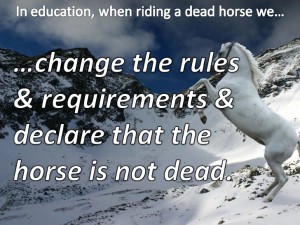After reading the Mike Petrilli blog about “universal proficiency by 2014,” it prompted recall of these words that are so central to our success:
“What is absolutely crucial in replication is that the assumptions, conceptions, values, and priorities undergirding what you seek to replicate are clear in your head and you take them seriously; you truly accept and believe them, they are non-negotiable starting points.” Seymour B. Sarason
The following is an excerpt from The Crucial Voice of the People, Past and Present posted here in an attempt to clarify parts of Dr. Sarason’s statement.
CONCEPTIONS: THE GOVERNING OF REFORM
Like most words, the word “conceptions” has different meanings. When applied to the replication of effective practices in education, both a “formulation of ideas” and the “beginning of some process” (Webster’s, 1976) seem applicable.
The governing of education is legally a state responsibility. The reality is that some states do a better job fulfilling that responsibility than others. Partially, it is because of differences in the way they are governed. For example, as the result of a lawsuit against the state of Massachusetts, a ruling was made that “all children must get an adequate education” and their 1993 Education Reform Act was created. The goals were to equalize funding among districts and improve all student performance.
The state chose to use these instruments for change (as outlined by Minnesota):
- increase state spending on education,
- create curriculum frameworks that set high expectations for student learning,
- create student performance assessments aligned with the curriculum frameworks.
But there was something else very important to Massachusetts’s success, the process. In section 3 of their law, they set up advisory councils in the following areas: early childhood education; life management skills and home economics; educational personnel; fine arts education; gifted and talented education; math and science education; racial imbalance; parent and community education and involvement; special education; bilingual education; technology education; vocational-technical education; global education; and comprehensive interdisciplinary health education and human service pro- grams. And the law specified “a reasonable balance of members,” that they should “be broadly representative of all areas,” and it described specifics for each advisory council.
We must continue to remind ourselves that we cannot take one piece of the equation for educational success or one aspect of a successful “model” without considering all the other factors that contribute to success. Summaries or “briefs” as presented here can never do justice to the bigger picture.
Massachusetts used their available experts and a broad range of interested community members to form councils that established their success factors. It couldn’t have been easy. Democratic processes never are. But “democracy is not attained through osmosis. It works because people recognize their responsibilities in it and put forth the effort to make it work through their actions” (Minzey & LeTarte, 1994, 88). And some states took note, like Minnesota, and followed suit. How their stories end, we can’t know. What we do know is that too many states are making uninformed decisions, are not using researched practices, are not using “experts,” are not adequately funding education, and are not using a democratic decision-making process. Some states fail to meet their responsibility.
*****
Today, America as a whole is not yet facing the fact that No Child Left Behind was based on faulty assumptions. We have paid a heavy price — made heavier the longer we ignore the fact that we have not been clear in demanding the best alternative for reauthorization.
Our non-negotiable starting points must guide us if we are to “get it right” (“it” being No Child Left Behind). Do we still value the ideals undergirding President Kennedy’s “twin goals”: “a new standard of excellence in education and the availability of such excellence to all who are willing and able to pursue it”?
The governing of the process by which we set —not standards, but— a standard of excellence matters. State responsibility, yes, but what of “local control”?






